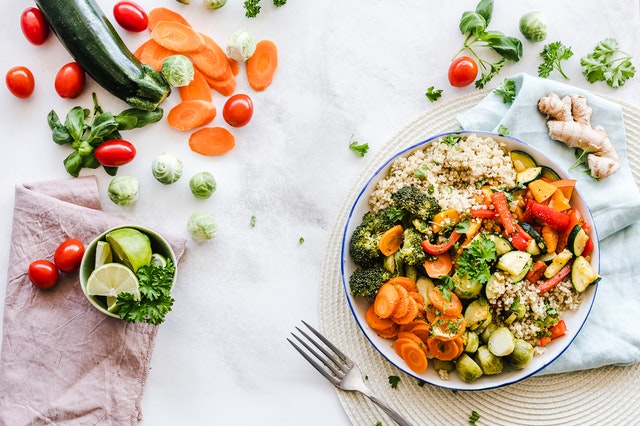If you don’t shop healthily, you can’t eat healthily. Follow these simple tips for a nutritious, successful trip to the grocery store.
When your life is already too busy, going to the grocery store can be a chore. But good nutrition starts with your weekly trips to the supermarket, so it’s important that you are making healthful choices. How can you tell if the choices you’re making are the best ones? Add these simple strategies to your arsenal, and your next grocery shopping trip will be a breeze!
Plan your grocery list so that you don’t forget anything—and to avoid impulse buys!
- Think about what you’ll need for breakfast during the week. Lunch? Dinner? Put all of these ingredients on your list! Giving your meals some forethought can help you save time, money and calories!
- Try not to purchase anything not on your list. If you do, be sure to read the nutrition labels to check for calories, fat and sugar content.
There are good choices in each section of the supermarket—you just have to look!
- Spend the most time in the produce section, Moreover, make sure to get a rainbow of hues to obtain the greatest range of vitamins and minerals. Even the pigments in the produce have benefits. For example, red fruits and vegetables get their color from a pigment called lycopene, shown to lessen the incidence of prostate cancer White fruits and vegetables are colored by anthoxanthin, has the potential to reduce cholesterol and hypertension.
- Go for 100% whole grain in the breads, cereals and pastas aisle for added fiber and protein. Whole grain means less processed! Check that the packaging says “100% whole grain” and that the first two words on the ingredients list are “whole grain” to be sure you’re getting the real thing!
- When buying meat, fish and poultry, choose lean cuts and skinless poultry. The loin is the leanest cut when shopping for beef, pork or lamb.
- In the dairy section, go for low-fat (1%) or nonfat whenever possible. Don’t like the consistency of the lower fat options? Try skim plus milk, which is fat free but has added calcium and protein to give it a creamier texture.
- Frozen foods don’t have to be a diet downfall. Plain frozen fruits and vegetables are almost as nutritious as fresh, and frozen dinners can be a convenient way to get a well balanced meal. But before you buy, be sure to check the nutrition label for the portion size and calorie, sodium, and fat content. If one serving of a frozen meal is under 300 mg sodium, 400 calories and 15 grams of fat, it’s a good choice for dinner tonight!
- Buy canned fruits and vegetables in the canned and dried foods aisle to ensure that you always have some on hand. When choosing, be sure to look for vegetables with the lowest sodium content and fruits packed in juice…and before eating them, rinse them to ensure you aren’t getting extra salt or sugar from the canning process! Keep dried beans, rice, pasta, low-fat and sodium soups, olive oil and nuts around the house to put together a quick meal or snack anytime!
- To ensure the health of yourself and your family, always buy water from the beverage aisle. If buying juice, always choose 100% fruit juice. Instead of soda, try seltzer with some fresh fruit or a splash of fruit juice for a little added flavor!
Don’t fall for supermarkets’ tricks—know how they get you to buy more!
- Start by shopping around the outside of the store, where most grocery stores keep their fresh foods (fruits, vegetables, dairy, meats and even fresh bakery items). Avoid the central aisles, where the majority of “junk food” is located. This “junk food” is usually highly processed, which means that the nutrients are processed right out of it! If you must venture into the center, stick to your shopping list, and try to purchase foods with no more than five ingredients. Although this is not always the case, as a general rule, the larger the number of ingredients, the less nutritious the food. And if you can’t say it, you shouldn’t buy it.
- At checkout, choose a “no candy lane” to avoid a last minute impulse buy. Out of sight, out of mind!
- “Organic” doesn’t necessarily mean “healthy”, just like cheap does not always mean unhealthy. To conduct such comparisons, it is necessary to read labels!
- Product packages that use the terms “reduced-”, “low-”, “-free”, and “light” are often misunderstood. For reference, in order for something to be labeled reduced fat, it needs to have 25% less fat than a similar item. Fat free means that there is less than 0.5g of fat per serving (though it can still be reported on the Nutrition Facts panel as “0 grams”), and light means that there are either 1/3 less calories or 50% less fat.
- The “healthier” items are usually displayed on the top and/or bottom shelves. Less healthy items (such as sugary cereals) are usually displayed on the middle shelves, at eye-level for children.
- Supermarkets design their displays to appeal to all of your senses—Don’t go to the grocery while you’re hungry, because you’ll purchase more than you meant.


